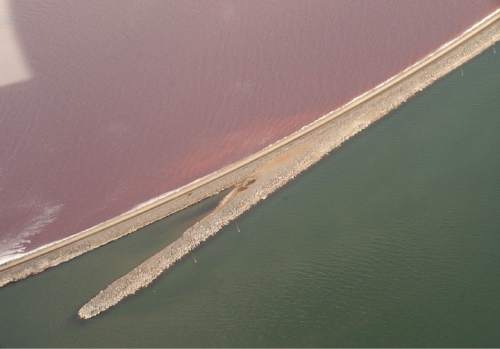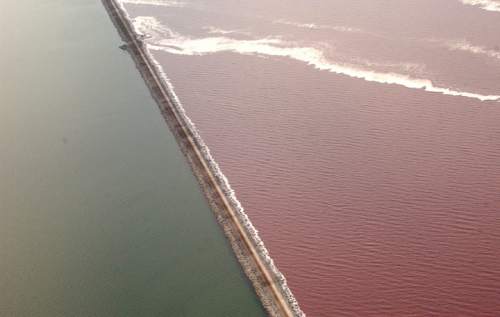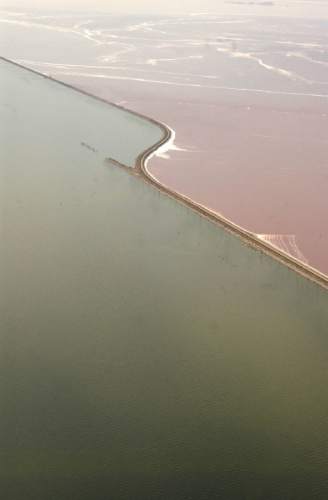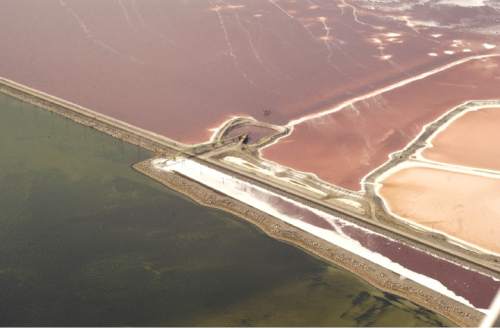This is an archived article that was published on sltrib.com in 2015, and information in the article may be outdated. It is provided only for personal research purposes and may not be reprinted.
The state of Utah and Union Pacific Railroad might have a solution for a damaged causeway that is cutting off water circulation at the northern end of the Great Salt Lake.
But first, the railroad company and state lands managers have to hammer out an agreement for the historic, 55-year-old railroad bridge that has never been signed.
The Division of Forestry, Fire and State Lands has repeatedly asked the railroad to apply for an easement to use the state-owned lake bed. But after four years, Union Pacific has yet to produce an adequate response, according to the division's Laura Ault.
State officials worry the railroad's refusal to secure the easement could lead to further delays for the long-awaited project.
"I'm not overly optimistic. The ball is in their court. They sent back a proposed lease that didn't meet state statutes. We couldn't entertain it," she told the Great Salt Lake Advisory Council last week. "We can do what we can to make it happen, but it depends on them being responsive."
Clearing up the easement is required before the state can approve a proposed 180-foot bridge that would span a breach in the 20-mile causeway between Promontory Point and the lake's western shore.
"The railroad maintains they have a legal right to be there," Ault said. "But they have never produced documentation to establish that and we don't believe they do."
Built in 1959 to speed rail travel, the causeway replaced the historic Lucin Cutoff trestle, built in the early 1900s by the Southern Pacific Railroad.
But travel times to the West Coast were not the only thing the structure cut off. It has permanently obstructed water flow between the lake's northern and southern arms, creating a super salty reddish soup to the north and a less-saline body to the south, where the Bear, Weber and Provo rivers infuse fresh water into the terminal lake.
The proposed breach and bridge are designed to replicate the role of two culverts installed to allow the mixing of lake water between the north arm's Gunnison Bay and the south arm's Gilbert Bay.
Because the causeway has been sinking for years, the railroad was forced to fill the culverts in 2012 and 2013 to ensure the safety of the 15 freight trains that cross it daily.
Losing the culverts has alarmed all Great Salt Lake stakeholders — from conservationists to land managers to extractive businesses who are keenly watching Union Pacific's plans to replace them with a bridge.
The project "is critical because not only does the ecology, the community of birds and brine shrimp, depend on the salt balance, but also industry, mineral extraction and brine sharp [egg harvests] depend on getting this right," said Jodi Gardberg from the Utah Division of Water Quality.
"If you allow too much north-to-south flow, you might poison the south arm. Gunnison Bay is so saline you could poison Gilbert Bay," she said. "That causeway [bridge] regulates salt if all goes well."
Now four years after the railroad sought emergency permission to fill the culverts, it has released a mitigation and monitoring plan that is open for public comment through Feb. 20, with a final decision scheduled by March 2.
The project would open a 150-foot gap in the causeway near the western shore. It proposes a five-foot-high earthen berm on the lake bed, which sits at 4,178 feet above sea level at this spot. The floor is only 15 feet below the current lake level.
Lower lake levels have complicated things. Utah's inland sea is approaching an historic low set in 1963, which further hinders mixing of the water.
While the proposed bridge is meant to recreate the function of the now-closed culverts, the state wants something more: a tool to allow for "adaptive" management of the lake's salt balance.
The lakebed berm is supposed to provide more direct control of the water, allowing officials to adjust the size of the opening if future monitoring indicates the land bridge is blocking natural mixing of the water. If there is not enough mixing, the opening can be enlarged. Or the berm can be raised, shrinking the opening if there is too much water going through.
The Utah Division of Water Quality and Army Corps of Engineers have to sign off.
"The project will have to perform as proposed for a minimum of five years for the agencies to determine that [Union Pacific] has met its permit obligations," Union Pacific Railroad spokesman Aaron Hunt wrote in an email.
After the monitoring period, the adjustable causeway opening will be turned over to the state "to make adjustments to facilitate management of the Great Salt Lake and its resources," Hunt added.
The railroad spokesman didn't know how much the new causeway will cost to build.
And who will be on the hook for maintaining the structure remains uncertain. State officials want the railroad to pony up.
"We don't want to allow them to build a large bridge and leave the maintenance to us," Ault told the advisory council. Union Pacific is "getting a private benefit, so you have to hold up the public trust if you want that benefit."
State water and lands managers define that public trust as a guarantee of continued "beneficial use" of the lake. Several companies have leases to pull brine from the lake and evaporate out valuable minerals, including salt and magnesium. And up to 5 million migratory waterfowl and shore birds use the lake to rest and dine on its bounty of brine shrimp and brine flies.
State officials believe the railroad has an obligation to ensure the causeway doesn't degrade those uses.
Hunt pledged that Union Pacific would "pay for all costs needed to meet its commitments under the permit and ensure that this mitigation project offsets the impacts of closing the culverts."
It will take nine months to build the berm and bridge, he said, which must be completed by the end of 2016. The railroad will build a temporary "shoofly" to carry rail traffic around the project area during construction.
Twitter: @brianmaffly









